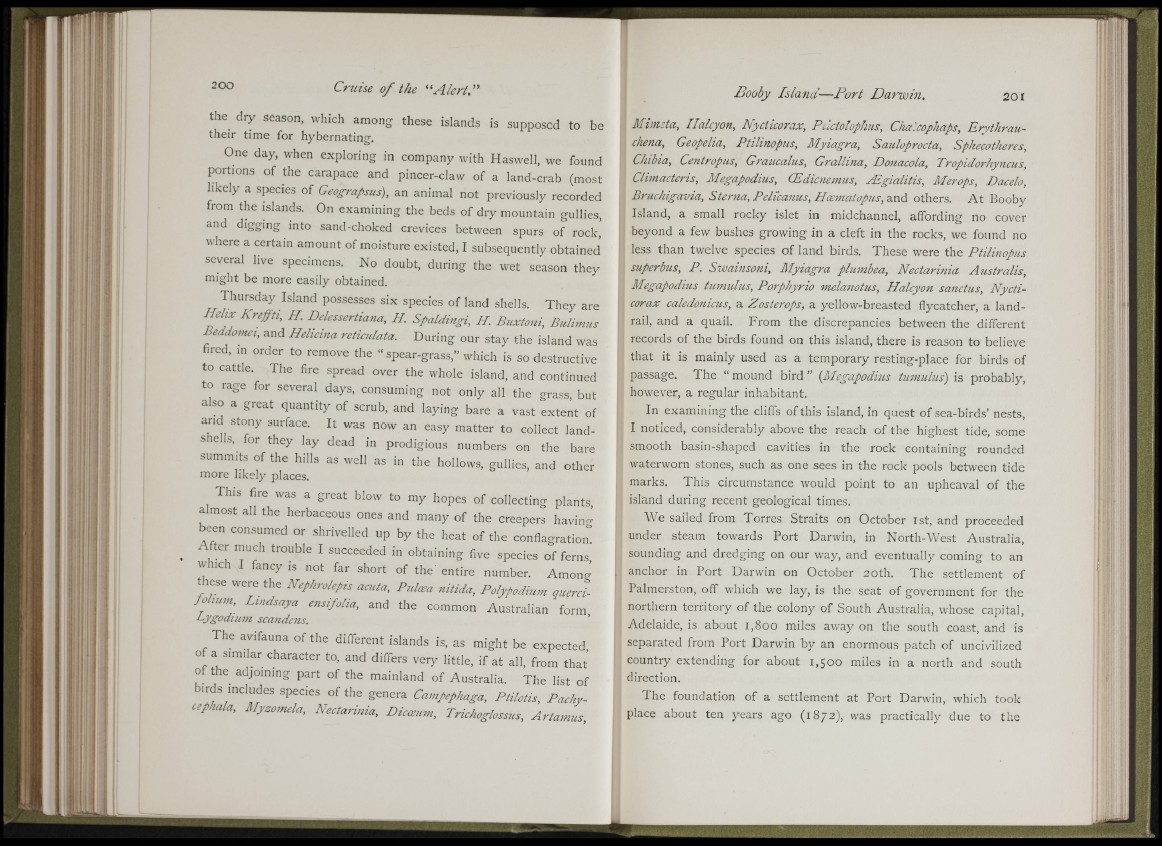
H Hi
J ' V i
■I V
r : I
r «
4 n
» '■
the dry season, which among these islands is supposed to be
their time for hybernating.
One day, when exploring in company with Haswell, we found
portions of the carapace and pincer-claw of a land-crab (most
likely a species of Geograpsus), an animal not previously recorded
from the islands. On examining the beds of dry mountain gullies,
and digging into sand-choked crevices between spurs of rock,
where a certain amount of moisture existed, I subsequently obtained
several live specimens. No doubt, during the wet season they
might be more easily obtained.
Thursday Island possesses six species of land shells. They are
Hdix Kreffti, PL Delessertiana, H. Spaldingi, H. Buxtoni, Bulunus
heddomci, and Helicina reticulata. During our stay the island was
fired, m order to remove the “ spear-grass,” which is so destructive
to cattle. The fire spread over the whole island, and continued
to rage for several days, consuming not only all the grass, but
also a great quantity of scrub, and laying bare a vast extent of
and stony surface. It was now an easy matter to collect landshehs,
for they lay dead in prodigious numbers on the bare
summits of the hills as well as in the hollows, gullies, and other
more likely places.
This fire was a great blow to my hopes of collecting plants,
almost all the herbaceous ones and many of the creepers havinbeen
consumed or shrivelled up by the heat of the conflagration
After much trouble I succeeded in obtaining five species of ferns
which I fancy is not far short of the entire number. Among
these were the Nephrolepis acuta, Pulaea nitida, Polypodium quercifohum
Ltndsaya ensifoUa, and the common Australian form
Lygodiuni scandens. ’
The avifauna of the different islands is, as might be expected
of a similar character to, and differs very little, if at all, from that’
of the adjoining part of the mainland of Australia. The list of
birds includes species of the genera Campephaga, Ptilotis, Pachy-
cephala, Myzcnela, Nectarmia, Dicmu„, Trichoglossus, Artamus
Miimta, Halcyon, Nycticoi'ax, P cectolophus, Chalcophaps, Ervthrau-
chena, Geopelia, Ptilinopus, Myiagra, Sauloprocta, Sphecotheres,
Chibia, Centropus, Graucalus, Grallina, Donacola, Tropidorhyncus,
CLimacteris, Megapodius, OEdicnemus, Ægialitis, Merops, Dacelo,
Bruchigavia, Sterna, Peli'canus, Hoernatopus,z.nà others. A t Booby
Island, a small rocky islet in midchannel, affording no cover
beyond a few bushes growing in a cleft in the rocks, we found no
less than twelve species of land birds. These were the Ptilinopus
superbus, P. Swainsoni, Myiagra plumbea, Nectarinia Australis,
Megapodius turmdus, Porphyrio melanotus. Halcyon sanctus, Nycti-
corax caledonicus, a Zosterops, a yellow-breasted flycatcher, a landrail,
and a quail. From the discrepancies between the different
records of the birds found on this island, there is reason to believe
that it is mainly used as a temporary resting-place for birds of
passage. The “ mound bird ” {Megapodius tumulus) is probably,
however, a regular inhabitant.
In examining the cliffs of this island, in quest of sea-birds’ nests,
I noticed, considerably above the reach of the highest tide, some
smooth basin-shaped cavities in the rock containing rounded
watcrworn stones, such as one sees in the rock pools between tide
marks. This circumstance would point to an upheaval of the
island during recent geological times.
We sailed from Torres Straits on October 1st, and proceeded
under steam towards Port Darwin, in North-West Australia,
sounding and dredging on our way, and eventually coming to an
anchor in Port Darwin on October 2oth. The settlement of
Palmerston, off which we lay, is the seat of government for the
northern territory of the colony of South Australia, whose capital,
Adelaide, is about i,8oo miles away on the south coast, and is
separated from Port Darwin by an enormous patch of uncivilized
country extending for about 1,500 miles in a north and south
direction.
The foundation of a settlement at Port Darwin, which took
place about ten years ago (1872), was practically due to the
y
¿1..
fer
Ê k